One of the most fascinating and addictive aspects of studying war history is the astonishment factor
In our daily lives we don’t encounter or witness extraordinary acts of bravery, sacrifice and suffering
That’s something that requires extremes in our environment ……not couch-slouching watching Games of Thrones or even working twelve hour days at the office
I take tour groups to the battlefields of the Western Front in France and Belgium. I have been doing this for over a decade. And I love it. I love to share my passion for the history, to share the stories, to make people marvel at what human beings are capable and not capable of in extremes
We stay in the medieval town of Wipers or Ypres (now Ieper) over the Belgium border, a town surrounded by the fortress walls built by Vauban (King Louis the 14th’s military advisor) and these walls are the reason why many centuries later Ypres was the only Belgian city to remain in Allied hands. 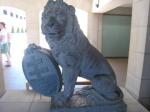 We see the 6,000 names of Australian soldiers who died fighting there in 1917 on the Menin Gate and is the town from where the medieval lion sculptures that guarded the city entrance were donated to Canberra by a grateful Belgian populace after WW1 for our sacrifice
We see the 6,000 names of Australian soldiers who died fighting there in 1917 on the Menin Gate and is the town from where the medieval lion sculptures that guarded the city entrance were donated to Canberra by a grateful Belgian populace after WW1 for our sacrifice
We visit Poperinghe – the tiny town behind the lines where Aussie Reverend Tubby Clayton held masses for his men in his little chapel in Talbot House – unchanged since 1915.
Tubby later bought the Pool of Peace – a blown crater in Ieper as a reminder never again to go to war. Nice try Tubby….
We visit the Essex Farm Dressing Station and sit in the spot where Canadian battle doctor McCrae wrote his poem upon the death of his friend: “In Flanders Fields Where Poppies Blow….”
In this spot we also take time to reflect on the grave of Valentine Strudwick who joined up aged 14 and died there of wounds aged 15….
And of course just outside Ieper is the site of one of the Christmas Truces of 1914 where Bruce Bairnsfather and his mates met their German counterparts, laughed, hugged, exchanged food, cigarettes, gifts, messages, kind wishes and played football in the snow before burying their dead and then hopping back into their trenches to recommence killing each other again 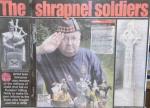
We visit “Shrapnel Charlie” a Belgian paraplegic who lives in Ieper and melts down bullets donated to him from the Iron Harvest from the fields. He makes tiny soldier figurines from these bullets and paints them and sells them for 4 euros each as his living from his home.
He is passionate about the history of his town, as everyone in Ieper is. He is as proud of the Australians in Ieper as any Aussie would be 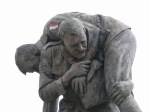
We go to Fromelles just over the border in France – the worst 24 hours in Australian history – and visit the scene of a battle catastrophe that claimed over 5,500 Australian casualties in 4 hours for absolutely nothing and broke the heart of Brigadier Pompey Elliott, the Aussie commander of the 15th brigade.
We remember them. We mourn them.
We go to the beautiful Notre dame de Lorette cemetery on the commanding ridge outside Lens where 40,000 French men are buried under crosses row on row and talk to the passionate volunteers les hommes en berets who cannot help you enough in telling the stories of the men who rest there. They have taken an oath to volunteer their time and every day of the year they are there to gratefully welcome the visitors from far who come to visit their dead.
Louise de Bettignies is honoured here too and you can see her cross. This brave Frenchwoman ran a massive spy network from Lille and saved over 9,000 British soldiers before she was caught, tortured and killed in Germany. This remarkable woman spoke English, French, German and Dutch. She dictated letters for dying German soldiers before she died of her torture wounds in Germany in 1918
To commemorate the 100th anniversary of WW1’s outbreak a huge steel sculptured mural has been built here containing the names of all the men who fought and died in that area – be they French, British, Belgian, Canadian, Aussie …. Or German. All names listed alphabetically only as a symbol of respect for all humanity and all men who died because they were made to.
We go to Arras and descend into the Wellington Quarry and walk the shafts and corridors dug by the Maoris and Aussies before the battle of 1917. We see the steps, beds, latrines and altars they carved and the very words, poems and pictures they drew before they leapt out to die on the fields of Arras
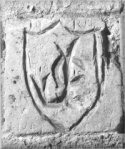 We go to Auchonvillers and see the makeshift hospital constructed in an old cellar that became a dressing station and stretcher bearers post during the battle of the Somme in July 1916. We see soldiers graffiti on the walls including the etchings of a young man condemned to death for being 16 years old and AWOL on the Somme from shell shock….
We go to Auchonvillers and see the makeshift hospital constructed in an old cellar that became a dressing station and stretcher bearers post during the battle of the Somme in July 1916. We see soldiers graffiti on the walls including the etchings of a young man condemned to death for being 16 years old and AWOL on the Somme from shell shock…. 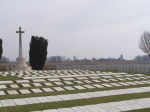
We see the impressive cemetery at Mill Road where the headstones lie flat because the ground caves in beneath them where the Germans had built such deep trenches before the Somme battle.
We go to Newfoundland park where an entire regiment from Newfoundland was wiped out in 45 minutes and where the Danger tree still stands from that very day today and
where I once found a soldier’s boot from WW1 – with the foot still inside it.
We visit Sunken Lane where Geoffrey Malins filmed his legendary Battle of The Somme film which shocked people throughout Britain when it was first filmed in 1916 to over 20 million people. Sunken Lane was where he took the now famous photo of the young Lancashire Fusiliers as they waited to die and near where he filmed the explosion of a mine which signalled the beginning of the first day of the Battle of the Somme.
It is also where a young man fell upon a broken grenade to save the lives of his mates in his trench and where the Military police shot dead their fellow countrymen if they refused from terror to mount the parapet and go into No Man’s Land
But it’s nowhere near where the Generals Rawlinson and Gough watched the battle. That was The Grandstand (above picture) well back towards Amiens which afforded them a good view but kept them very safe as their soldiers followed their order to march slowly over the top to their deaths
And we go to the town twinned with Robinvale in Victoria – Villers Bretonneux where Australian soldiers fought so valiantly they almost saved the war for the British (they and later the magnificent Canadians) on Anzac day in 1918. Without their awesome bravery Amiens may have fallen to the Germans and the course of WW1 quite different.
VB is where the Anzac Dawn Service is held every year on April 25th and where the whole town honours Australia’s sacrifice and how they saved them from German tyranny on this special day and where the Victoria School houses the Australian museum and with the words Do Not Forget Australia in its schoolyard and where streets are called rue de Melbourne and rue d’Anzac.
We go to the site of the 94 minute victorious battle of le Hamel – meticulously planned by Aussie General Monash which became the blueprint for ensuing army battles it was so decisive a victory
We continue on to Peronne and Mont St Quentin where Aussies performed more acts of extraordinary bravery fighting the Germans during their final push from the Hindenburg Line without sleep for weeks though vastly outnumbered.
It is also where General Pompey Elliott having moments before been shot in the buttocks, addressed his troops with his pants to his knees whilst the medical orderly stitched him up – and he still got a standing ovation!
TOURS TO THE WESTERN FRONT
If you are interested in joining me then checkout the French Fusion website below as there are 2 unique departures in 2015 barging the Somme and Belgian canals and staying on our own barge fully catered and looked after to attend the Anzac dawn service at Villers Bretonneux or visit the Western Front battlefields in May of 2015 to commemorate the 100th year anniversary of Anzac Day
(please note that not all things mentioned here will be visited on the 2015 schedule as we are barging on a canal and limited in time to visit only one to two places per day. The visits above are an amalgam of previous visits and the emotion they bring when you know the story behind them)

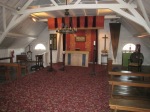











Pingback: Anzac Dawn Service small group tour and canal luxury barge fully guided FranceFrench Travel Specialists in France·